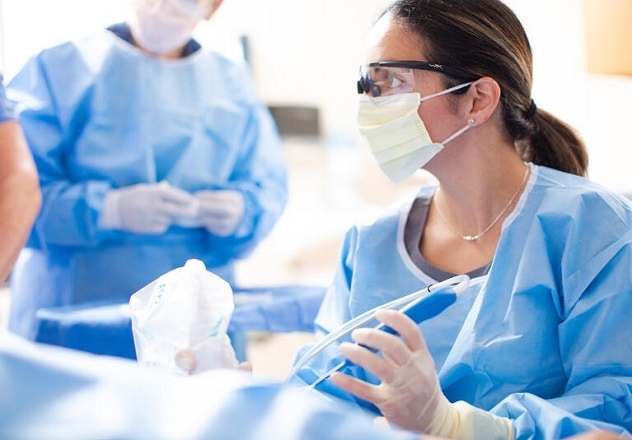Oct. 10, 2023
The Achilles tendon is one of the largest and strongest tendons in the body, capable of withstanding about 12.5 times the human body weight in a ballistic activity. Because it crosses two joints, the knee and the ankle, it is vulnerable to injury.
Achilles tendinopathy is a common overuse injury, with an estimated lifetime incidence of up to 24% in athletes. Both degenerative and inflammatory changes of the Achilles tendon can occur, sometimes leading to tendinopathy. Inflammation can begin suddenly after an injury or more gradually as a result of wear and tear.
Characteristics of this condition include focal tendon enlargement, with or without neovascularity and partial tearing. The proliferation of small vessels and accompanying nerves is another possible source of pain in chronic Achilles tendinopathy.
"We often see patients present with a gradual onset of pain, sometimes accompanied by swelling or enlargement, at the midportion or the insertion point of the Achilles tendon on the calcaneus," explains Marianne T. Luetmer, M.D., a physiatrist at Mayo Clinic in Rochester, Minnesota. "This pain typically worsens during running, jumping and even walking if severe. It often affects patients who have changed their training routines or increased their mileage or exercise intensity.
Characteristics of Achilles tendinopathy
Achilles tendinopathy can be classified as noninsertional or insertional.
- Noninsertional tendinopathy, also known as midportion or midsubstance, is the most common form, occurring between posterior the tibial and peroneal arteries.
- Insertional tendinopathy occurs at the tendon's insertion point on the calcaneus. It may or may not be associated with calcaneal enthesophytes or cortical irregularity; retroachilles or retrocalcaneal bursopathy or bursitis; or Haglund deformity.
Risk factors
Achilles tendinopathy is more common in men age 60 and older. The risk of this condition is also elevated in individuals with metabolic or rheumatologic diseases, individuals who are taking fluoroquinolones or steroids, and individuals with any of the following biomechanical issues:
- Planus/forefoot hyperpronation.
- Pes cavus.
- Subtalar joint immobility.
- Gluteal weakness.
- Foot core muscle weakness.
Extrinsic or modifiable risk factors for Achilles tendinopathy are often related to changes in exercise habits or footwear issues, including the following:
- Abrupt increase in running mileage or intensity.
- New terrain.
- Running on hard or hilly surfaces.
- Footwear with insufficient heel height, rigid soles, inadequate shock absorption or uneven wear.
Conservative management
According to Dr. Luetmner, conservative management often starts with identifying and correcting modifiable risk factors, including biomechanical issues, shoe modifications and physical therapy. Patients with midportion tendinopathy can benefit from either eccentric/Alfredson protocol or heavy, slow resistance, while those with insertional tendinopathy can benefit more from a modified eccentric/Alfredson protocol. There is mixed evidence supporting the use of topical glycerin trinitrate in the midportion group and shock wave therapy in the insertional group. There is mixed evidence for prolotherapy and use of nonsteroidal anti-inflammatory drugs (NSAIDs) in both groups.
Interventions
Corticosteroid injections. These are sometimes used to treat retrocalcaneal bursitis. "Because there is a about a 2% risk of tendon rupture, we recommend considering other options for treatment after an injection that is not helpful," says Dr. Luetmer.
Ultrasound-guided percutaneous needle tenotomy with platelet-rich plasma (PRP). In this procedure, the physician delivers the PRP to the most diseased portion of the tendon using an ultrasound-guided needle. "Although the body of research examining the effectiveness of this procedure is growing, most of the available study data are from patients with Achilles tendon rupture, so additional research addressing the use of PRP in Achilles tendinopathy is needed," notes Dr. Luetmer.
Dr. Luetmer explains that PRP is contraindicated for individuals with blood dyscrasias or a cancer diagnosis (other than some skin cancers) within the past five years. "The use of anticoagulant or anti-platelet medications for cardiac indications is not a contraindication, but we do make patients aware that the effect of these medications on platelet efficacy in vivo is unclear," says Dr. Luetmer.
 Ultrasound-guided percutaneous pressured hydrotenotomy
Ultrasound-guided percutaneous pressured hydrotenotomy
This procedure uses a high-pressure saline stream to selectively debride and aspirate diseased tissue while preserving healthy surrounding tissue.
Ultrasound-guided percutaneous pressured hydrotenotomy. This procedure uses a high-pressure saline stream to selectively debride and aspirate diseased tissue while preserving healthy surrounding tissue.
"Under ultrasound, the high-pressure stream is targeted toward the softer, degenerative part of the tendon, and continuous irrigation flushes out that debrided tendon," explains Dr. Luetmer. "Essentially, the goal is to approximate edges of healthy tendon to facilitate healing. After the procedure, patients are put in a boot and crutches for the first few weeks. Patients then undergo a very specific physical therapy protocol for 12-16 weeks. The procedure is not performed if there is a tear involving 50% or more in the tendon. Mayo Clinic staff are working to build a database of patient outcomes to optimize patient selection and timing for administering this treatment."
Neovessel ablation. Mechanical tendon scraping, which doesn't involve touching the tendon, can be used to reduce the neovascularity sometimes associated with this condition and thought to contribute to pain. Dr. Luetmer explains that this procedure is typically used to treat midportion tendinopathies rather than insertional, and it may be a good option for an athlete who can't take the time away required to recover after hydrotenotomy procedures.
The procedure can be performed using a mini-open surgical approach or via a less invasive, ultrasound-guided approach. The latter appears to provide the same outcomes for pain relief and function as the surgical approach, with a quicker return to play and high patient satisfaction scores. But Dr. Luetmer notes that more robust studies of this treatment are needed.
"Identifying which of these interventions is most effective for patients with Achilles tendinopathy is still a challenge," says Dr. Luetmer. "However, as we learn more about outcomes, we hope to help patients choose a cost-effective option with optimal likelihood of long-term improvement in pain and function."
For more information
Mayo Clinic Physical Medicine and Rehabilitation Medical Professionals Resources
Refer a patient to Mayo Clinic.